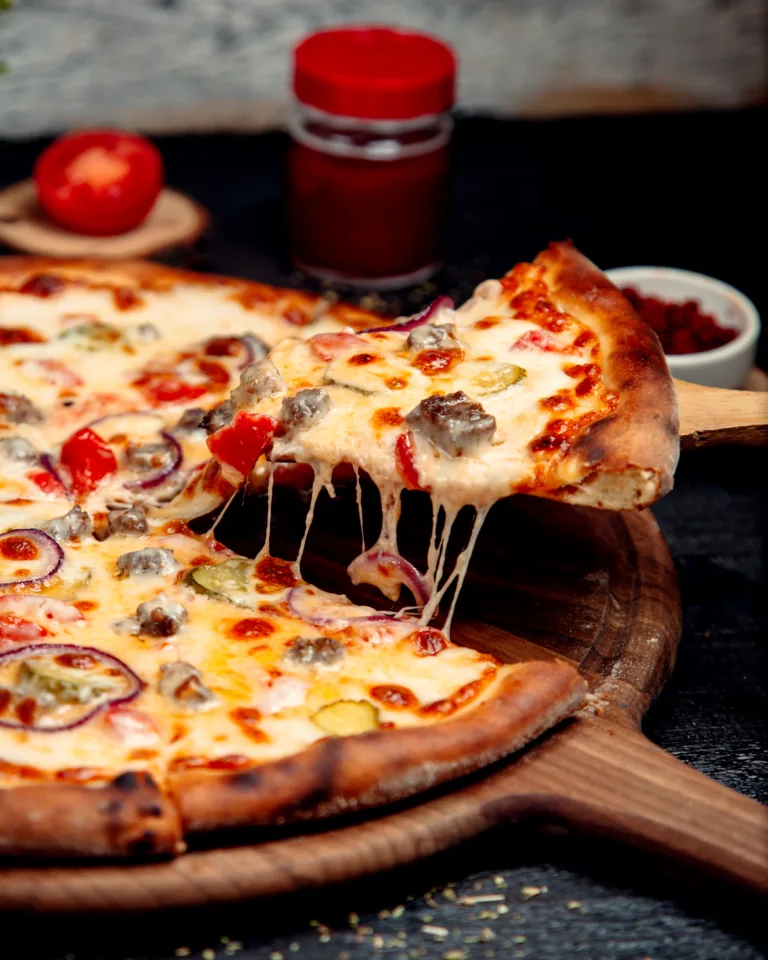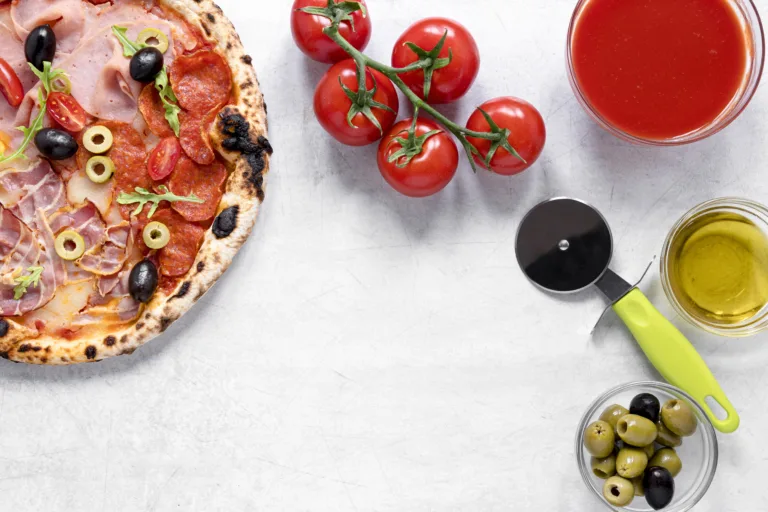
Pizza Nutrition Facts: Is Pizza Healthy? Benefits and Tips
Introduction
Pizza is a beloved and popular dish enjoyed by people of all ages. In this article, we will delve into the nutrition facts of pizza, examining whether it can be considered a healthy choice.
We will explore the benefits of pizza, discuss potential downsides, and provide practical tips on how to make your pizza more nutritious.
- Is Pizza Healthy?
Pizza can be a part of a healthy diet when consumed in moderation and made with wholesome ingredients. However, it is important to consider the overall nutritional composition and portion sizes. By choosing healthier toppings and crust options, pizza can offer essential nutrients.
- Benefits of Pizza
Convenience
Pizza is readily available and can be a convenient meal option. Whether you order it from a local pizzeria or make it at home, pizza is a versatile and time-saving choice.
Versatile
One of the significant advantages of pizza is its versatility. It allows for a wide range of ingredient choices, catering to various dietary preferences. Whether you’re a meat lover, vegetarian, or follow a specific eating plan, you can customize your pizza toppings to suit your taste and nutritional needs.
Nutritional Value
Contrary to popular belief, pizza can provide essential macronutrients such as carbohydrates, proteins, and fats. The nutritional value of pizza primarily depends on the ingredients used. Opting for whole wheat or whole grain crust can increase fiber content.
Toppings like vegetables contribute essential vitamins, minerals, and antioxidants to the pizza, enhancing its nutritional profile.
Enjoyment
Pizza is a popular comfort food that can bring joy and satisfaction when enjoyed in moderation. Treating yourself to a delicious pizza once in a while can be a source of happiness, promoting a positive relationship with food.
- Potential Downsides
While pizza can offer nutritional benefits, it’s crucial to be aware of its potential downsides to make informed choices.
High-Calorie Content
Some pizzas can be high in calories, especially if loaded with fatty meats and excessive cheese. To manage calorie intake, it’s essential to control portion sizes and choose lighter toppings.
Sodium Intake
Processed meats, cheese, and sauces used in pizzas can contribute to high sodium levels. Excessive sodium intake may not be suitable for individuals with certain health conditions, such as high blood pressure or kidney problems. Opting for lower-sodium ingredients and moderating the use of salt can help mitigate this concern.
Unhealthy Ingredients
Certain commercially available pizzas may contain artificial additives, preservatives, and unhealthy fats. It’s essential to read labels and opt for pizzas made with fresh, wholesome ingredients. Alternatively, making pizza at home allows you to have control over the quality of ingredients.

- How to Make Pizza More Nutritious
To enhance the nutritional value of your pizza, consider implementing the following tips:
Opt for Whole Grain Crust
Choose whole grain or whole wheat crust for added fiber and nutrients. These crust options provide more complex carbohydrates and can help regulate blood sugar levels compared to refined flour crusts.
Load Up on Vegetables
Include a variety of colorful vegetables as pizza toppings to boost the nutritional value. Vegetables like bell peppers, tomatoes, mushrooms, spinach, and onions not only add flavor but also provide vitamins, minerals, and dietary fiber.
Reduce Cheese Amount
Use a lighter hand when adding cheese to control calorie and fat intake. Opt for low-fat or part-skim cheese varieties, and consider using them sparingly. Alternatively, you can explore dairy-free or plant-based cheese alternatives for a lower-calorie option.
Choose Lean Protein
Opt for lean meats like grilled chicken or turkey instead of high-fat options like sausage or pepperoni. Seafood, such as shrimp or grilled fish, can also be a healthy and flavorful protein choice. For vegetarians, options like tofu, tempeh, or legumes can provide ample protein.
Homemade Sauce
Make your own pizza sauce using fresh ingredients to avoid added sugars and artificial additives. This way, you can control the amount of salt and choose healthier alternatives like herbs and spices to enhance the flavor.
Frequently Asked Questions
Is pizza suitable for individuals following a vegetarian or vegan diet?
Yes, pizza can be customized with vegetarian or vegan toppings, such as plant-based cheeses and a variety of vegetables. You can create delicious and nutritious pizzas using ingredients that align with your dietary preferences.
How might I lessen the calorie content of pizza?
Choose thin crust options, opt for lighter cheese, and load up on vegetables while keeping meat portions moderate. These choices can help reduce the overall calorie content of your pizza without compromising taste.
Might pizza at any point be a piece of a weight reduction diet?
Yes, pizza can be enjoyed as part of a weight-loss diet. However, portion sizes should be controlled, and healthier toppings and crust options should be chosen. By incorporating the tips mentioned above, you can enjoy pizza while maintaining a calorie deficit.
Is gluten-free pizza available?
Yes, many pizzerias and grocery stores offer gluten-free crust options for individuals with gluten intolerance or sensitivity. These crust alternatives are typically made with gluten-free flour, such as rice flour or almond flour, ensuring a safe option for those with specific dietary requirements.
By following these tips, you can enjoy pizza while making it a more nutritious choice. Remember, moderation is key, and making conscious choices about ingredients and portion sizes can contribute to a healthier pizza-eating experience.
Share your favorite pizza recipes or tips for making pizza healthier in the comments below! Let’s make pizza a delicious and nutritious delight for everyone.
End
Pizza can be a part of a balanced and healthy diet when consumed mindfully. By understanding its nutrition facts, choosing wholesome ingredients, and implementing simple strategies, you can make pizza a more nutritious option. Enjoy your pizza while also taking care of your health.
An authentic recipe for gluten-free pizza
Ingredients:
For the crust:
- 1 ½ cups gluten-free all-purpose flour
- 1 teaspoon xanthan gum
- 1 teaspoon baking powder
- ½ teaspoon salt
- 1 teaspoon dried Italian herbs (optional)
- 2 tablespoons olive oil
- 1 teaspoon apple cider vinegar
- ½ cup warm water
- For the toppings:
- ½ cup gluten-free pizza sauce
- 1 ½ cups shredded mozzarella cheese (or dairy-free alternative)
Your selection of fixings, for example, cut chime peppers, onions, mushrooms, olives, and so on.
New basil leaves for embellish
Directions:
Preheat your broiler to 425°F (220°C) and line a baking sheet with material paper. In a mixing bowl, combine the gluten-free all-purpose flour, xanthan gum, baking powder, salt, and dried Italian herbs (if using).
Add the olive oil and apple juice vinegar to the dry fixings. Mix well to incorporate the oil evenly.
Steadily add the warm water to the combination, blending ceaselessly. Continue mixing until you achieve a soft and slightly sticky dough.
Dust a clean surface with gluten-free flour and transfer the pizza dough onto it. Knead the dough gently for a few minutes until it becomes smooth and pliable.
Carry out the batter into your ideal pizza shape and thickness. If the dough sticks, dust it with more gluten-free flour as needed.
Carefully transfer the rolled-out crust onto the prepared baking sheet. Pre-bake the crust in the preheated oven for about 10-12 minutes or until it becomes slightly golden.
Remove the crust from the oven and spread the gluten-free pizza sauce evenly over the pre-baked crust.
Sprinkle the shredded mozzarella cheese (or a dairy-free alternative) over the sauce, covering the entire surface of the pizza.
Add your desired toppings, such as sliced bell peppers, onions, mushrooms, olives, etc.
Place the pizza back in the oven and bake for an additional 10-15 minutes, or until the cheese is melted and bubbly, and the crust is golden brown.
Eliminate the pizza from the broiler and let it cool for a couple of moments. Garnish with fresh basil leaves.
Slice the gluten-free pizza into wedges and serve hot.

Enjoy your delicious homemade gluten-free pizza!
Gluten-free pizza sauce recipe.
Certainly! Here’s a simple and delicious recipe for gluten-free pizza sauce:
Ingredients:
- 2 tablespoons tomato paste
- 2 cloves garlic, minced
- 1 teaspoon dried oregano
- 1 teaspoon dried basil
- ½ teaspoon salt
- ¼ teaspoon black pepper
- 1 tablespoon olive oil
- 1 teaspoon honey (optional, for sweetness)
- 1 can (14 Oz) crushed tomatoes
Instructions:
1- In a pan, heat the olive oil over medium intensity.
2- Add the minced garlic to the saucepan and sauté for about 1 minute, until fragrant.
3- Add the crushed tomatoes and tomato paste to the saucepan. Stir well to combine.
4- Add the dried oregano, dried basil, salt, and black pepper to the saucepan. Stir again to incorporate the herbs and seasonings into the sauce.
5- If you prefer a slightly sweet flavor, you can add a teaspoon of honey to the sauce. This step is optional.
Reduce the heat to low and let the sauce simmer for about 15-20 minutes, stirring occasionally. This will permit the flavors to merge together and the sauce to somewhat thicken.
Taste the sauce and change the flavors according to your tendency. Add more salt, pepper, or spices whenever wanted.
When the sauce has arrived at the ideal consistency and flavor, eliminate it from the intensity and let it cool.
When cooled, the without-gluten pizza sauce is fit to be utilized. You can store it in a sealed shut holder in the cooler for as long as 5 days.
Use this delicious gluten-free pizza sauce as a base for your homemade gluten-free pizzas. Enjoy!
Note: Ensure that all the ingredients used, including the canned crushed tomatoes and tomato paste, are certified gluten-free to avoid any gluten cross-contamination.

